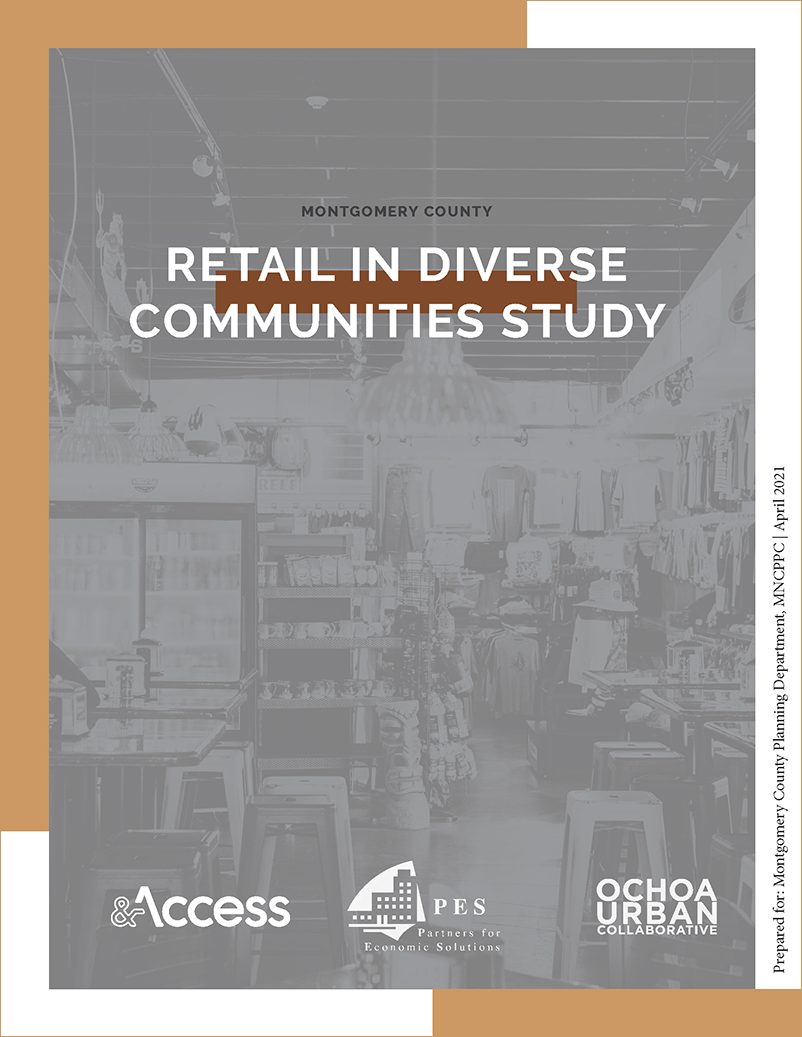
Retail in Diverse Communities documents
Summary
The Montgomery County Planning Department, in partnership with the Small Business Navigator and the Montgomery County Economic Development Corporation, studied tools and policies to help preserve and strengthen clusters of retail that provide goods and services heavily catering to minority and ethnic sub-groups. These clusters of “diverse retailers” contribute to the vibrancy of Montgomery County and often serve as community anchors and social support networks for foreign-born populations and communities of color. However, continued development and rent growth can threaten to displace these clusters in the absence of policies and initiatives to support them.
Findings
Montgomery Planning selected for analysis the downtown Silver Spring, Wheaton, and Takoma-Langley neighborhoods as they have prominent clusters of retailers serving international communities. The effort built upon a prior analysis of tools to preserve and strengthen the international retail cluster in the Long Branch neighborhood conducted by University of Maryland students in a fall 2019 Partnership for Action Learning in Sustainability (PALS) class done in partnership with Montgomery Planning.
The 279 diverse retailers spread across Silver Spring, Takoma-Langley Crossroads, and Wheaton have a prominent role in their neighborhoods, generating nearly 1,400 jobs and approximately $137.9 million in sales. The value these businesses bring to their communities, as community anchors and hubs of social support network, surpasses the traditional metrics associated with economic impact (sales, tax revenue, etc.). These qualitative functions allow diverse retail entrepreneurship to grow, increasing businesses’ ability to locate, thrive, and expand in the neighborhoods they call home.
While some diverse retailers in this study have operated for up to 60 years in the neighborhoods they serve, they are currently facing many real challenges. These challenges are a result of systemic and systematic barriers to access, equity, and opportunity. The challenges identified include the following:
- Technical assistance: limited county staff capacity and limited business owner resources;
- Real estate: barriers to occupancy, risk of displacement, prohibitively high rents in newly constructed buildings;
- Capital and financing: finite funding and financing opportunities; and,
- Policy and public investment: Impacts of construction on accessibility and visibility, exclusive eligibility requirements, limited protections for neighborhood character.
Recommended Tools
To preserve diverse retailers and address the challenges faced, the study identified and recommended implementation of the following tools. More information about each tool is available in the report.
- Diverse Retail Liaison
- Legacy and Minority Business Designation
- Bill of Rights and Leasing Support
- Micro Retail Zoning
- Commercial Overlay Zone
- Loan Pool
- Monthly Tax Bill
- Small Business Impact Policy
- Placemaking
Long Branch UMD PALS Study Findings
The 2019 Long Branch study titled “A Long Life for Long Branch: tools to preserve independent retailers” documented current conditions and provided a comprehensive set of potential tools that could help preserve and enhance retail in the area. Through interviews with business owners and analysis of County data, this study found that:
- Transformative placemaking and place-based investment can support neighborhood prosperity;
- Few retailers own the building their business occupies;
- Many owners of retail businesses in the Long Branch retail cluster are minority and/or foreign-born;
- Small business is at a disadvantage in negotiating with landlords, developers, and banks;
- Independent businesses have difficulty accessing technical assistance and financing tools available; and,
- Displacement threatens both the retailers as well as the customers they serve.
The Long Branch study evaluated 10 potential tools against the threats facing the Long Branch retail cluster:
- Neighborhood commercial overlay zone
- Commercial inclusionary zoning
- Community benefits agreements
- Neighborhood equity coordinator
- Targeted small business assistance
- Community improvement districts
- Commercial tenant bill of rights and leasing support
- Various targeted financial tools
- Community land trusts
- Legacy or landmark business designation